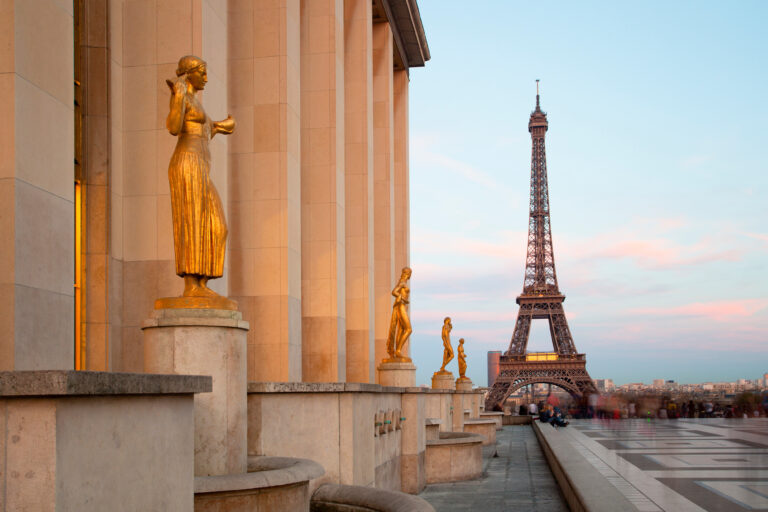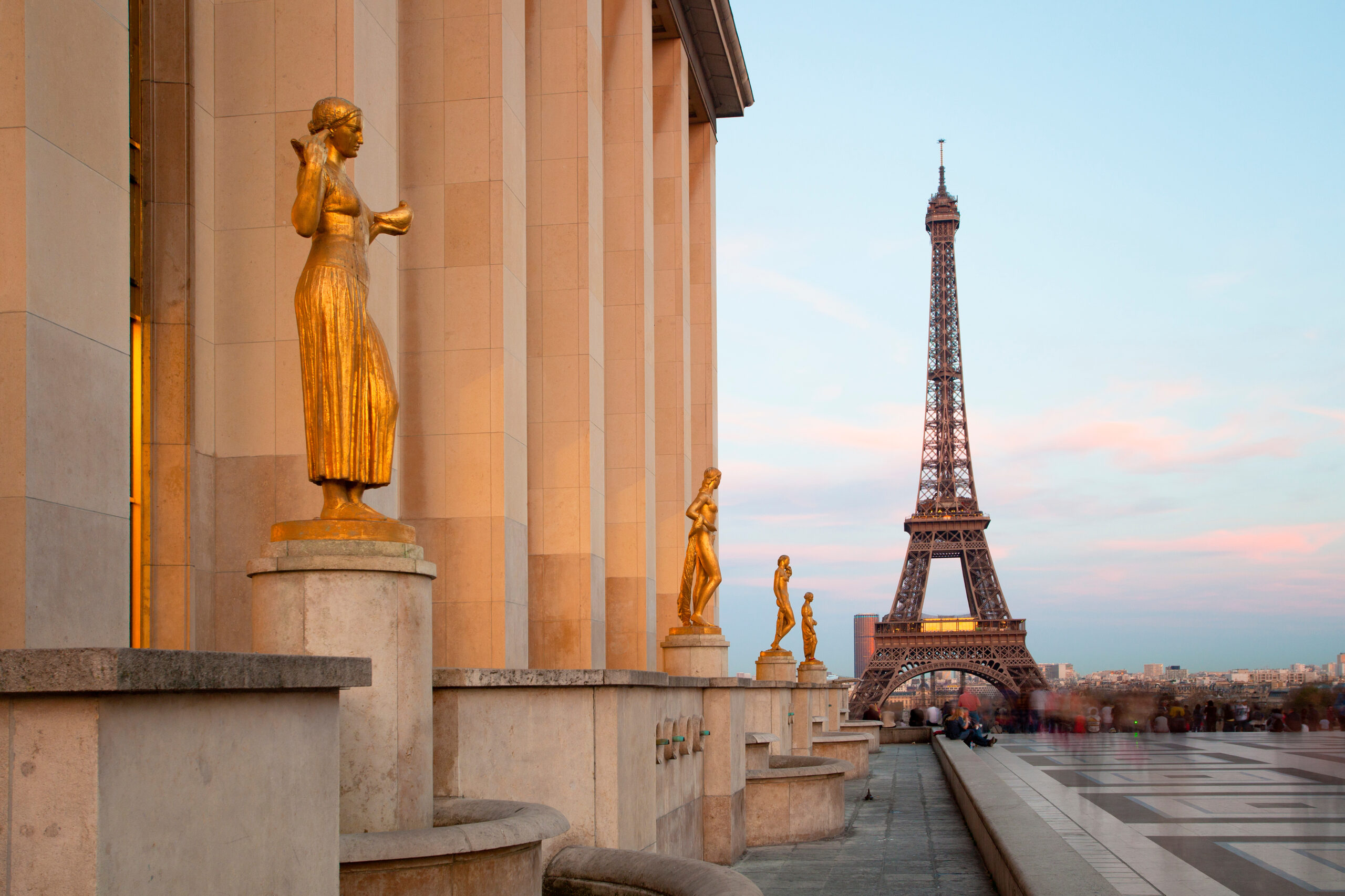
View of the Eiffel Tower from the Trocadéro.
Paris, France – it’s the number-one most visited city in the world, and considering its world-renowned museums, gastronomy, fashion and design, shopping, and entertainment, it’s easy to see why.
The city’s history runs far, deep, and wide, with origins reaching back as far as the 3rd century BCE when the Parisii, a sub-tribe of Celtic Senones, inhabited the area until the Romans conquered and began settling in 52 BCE. Now, Paris boasts a population of over 2.1 million, making it the fourth most populous city in the European Union, and it remains one of the world’s major centers of finance, diplomacy, commerce, and culture. Perhaps best known for being the “City of Love,” many of its iconic landmarks, such as the Eiffel Tower and the many intricate bridges over the River Seine, have become symbols of romance. But that’s obviously just barely scratching the surface of what the city has to offer.
Below, we’ve curated a guide with our expert advice on how to get the most out of your trip to Paris. Read on for more information on the city’s best neighborhoods, cuisines, activities, attractions, and more. And if you don’t have plans to visit but are inspired to, consider our collection of tours featuring stays in Paris.
Table of Contents
- The Basics: Language, Currency, Climate, & Safety
- Getting Around: The Metro
- Food & Cuisine
- Restaurant & Dining Etiquette
- 10 Areas to Visit
- 10 Famous Attractions
- Useful Information
- Useful Apps
- Useful Websites
The Basics
- Language – French is the official language in Paris, but due to its position as a global epicenter, many Parisians – especially those working in the tourism industry – have some level of fluency in other languages, especially Italian, German, Arabic, and English. Do note that, though over half of all Parisians have some knowledge of English, it is often only a very basic knowledge. So, you should plan to learn some basic French in order to communicate effectively.
- Currency – France’s official currency is the euro (abbreviated € or EUR), the common legal tender of 20 members of the European Union. Bills are issued in denominations of 5, 10, 20, 50, 100, 200, and 500 euro. Coins come in 1, 2, 5, 10, 20, and 50 cents, as well as 1 and 2 euro. Visit xe.com for up-to-date exchange rates.
- Climate – The climate in Paris is similar to some regions of the Eastern United States, with winters lingering in the 30–50°F range and summers reaching up to around 80°F (though in recent years, summer heat waves have reached as high as the mid-90s). Northern France can be occasionally unpredictable and wet like its English neighbor; weather can go from sunshine to rain in a matter of minutes during certain seasons. Visit accuweather.com for more climate information.
- Safety – In Paris, violent crime is rare; petty crime should be your biggest concern, as in most large, urban places. Pickpocketing is particularly common in high-traffic areas. Practice common sense safety measures: keep your belongings secure when in public, avoid being out in unfamiliar areas late at night, and travel with a buddy if possible (and if not, consider frequently sharing your location with loved ones).
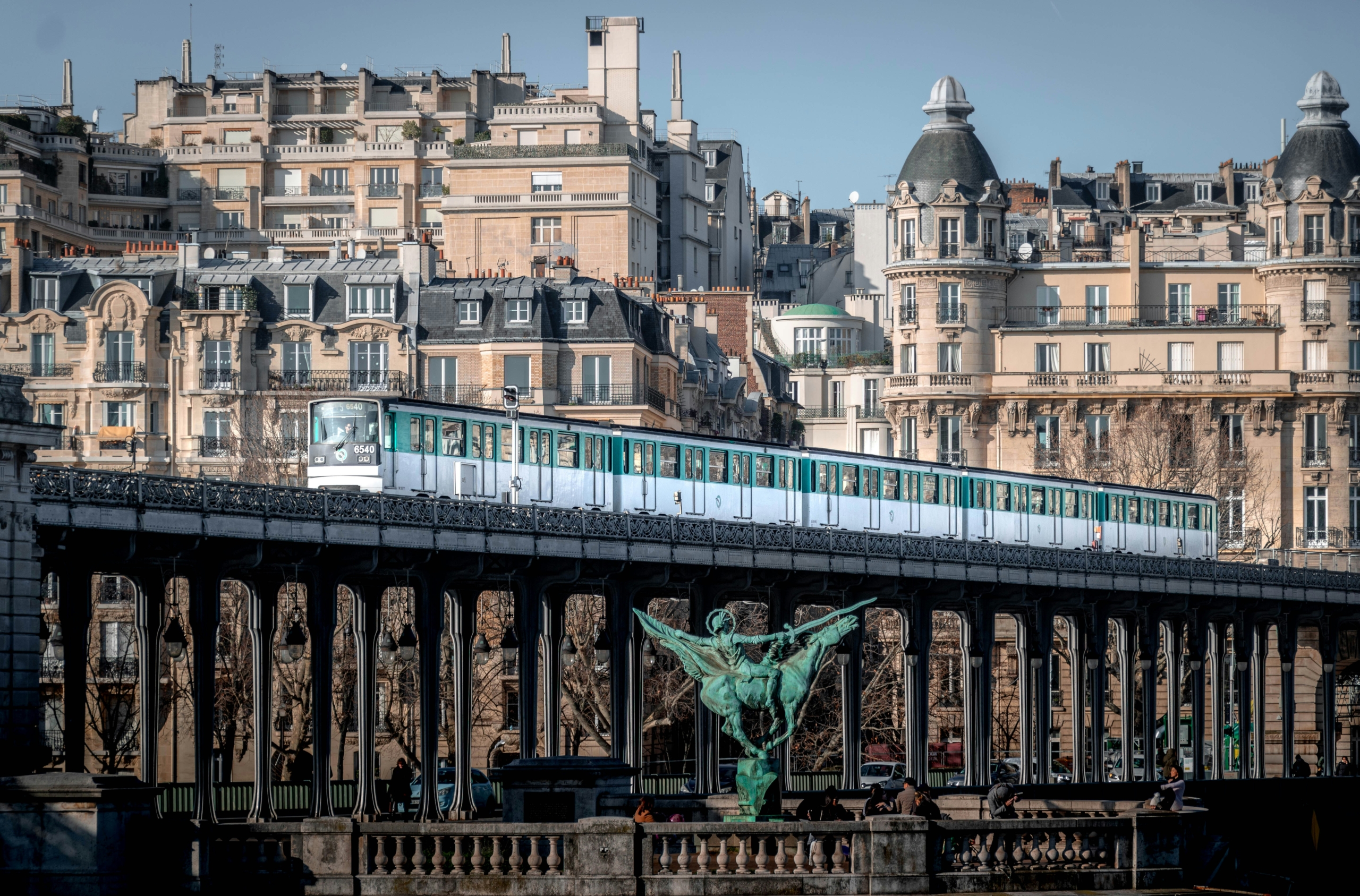
A Metro train passing over Pont de Bir-Hakeim in Paris.
Getting Around: The Metro
No need to hail a taxi or call an Uber; Paris has one of the safest and most efficient public transportation systems in the world, allowing you to hop between the city’s 20 arrondissements municipaux (administrative districts, commonly referred to simply as arrondissements) with ease.
The Metro consists of a network of buses and trains. The easiest and cheapest way to use the Metro is by purchasing a Navigo weekly or monthly pass. The Navigo pass works on city buses, trains, and trams; the RER (Réseau Express Régional), which connects the city center with popular sites like Charles de Gaulle Airport, Disneyland Paris, Orly Airport, the Palace of Versaille, and others; and the Montmartrobus, the Noctilien, and the Montmartre furnicular. You’ll have to choose the zones you wish to travel within upon purchase, and the card will only be valid for use in those zones. Or, you can buy a pass valid for all zones for just a slightly higher price (around €30 or $32 for a week pass and €84 or $91 for a month pass).
For more information on the Paris Metro, visit www.ratp.fr/en.
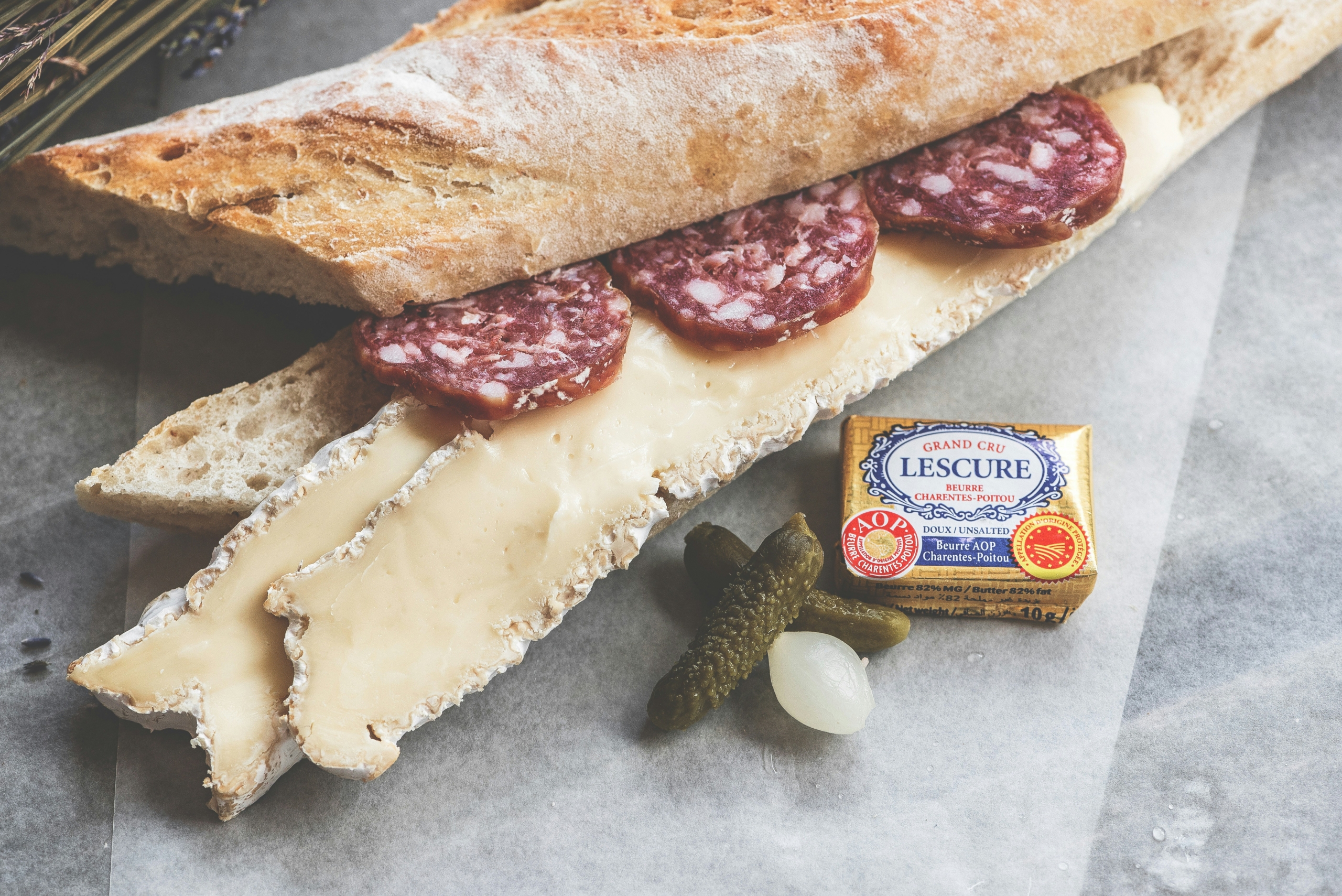
A typical casual French meal: baguette, cheese, and cured meat.
Food & Cuisine
There is certainly no shortage of delicious foods to try in Paris. French cuisine is known throughout the world for its refined flavor combinations, cooking techniques, and overall excellence – so you should certainly plan to indulge in some local specialties. Including a full list of must-try Parisian foods and meals would be impossible, but here are some of our recommendations:
Foods:
- Pastries and breads – croissants, baguettes, macarons, éclairs, pain au chocolat (chocolate-filled croissant-like pastry), crêpes
- Seafoods – escargot (snail), caviar (sturgeon roe), oysters, fish
- Wines – Consider trying wines from the most renowned wine regions of France: Bordeaux, Burgundy, Champagne, Alsace, the Rhône Valley, and the Loire Valley.
- Cheese – You may know of Camembert and Brie, but France offers over 300 varieties, so the choice is yours to make.
- Coffee – Rather than drinking a cup (or several) of regular brewed coffee in the morning, the French prefer sipping on espresso throughout the day, especially after meals. If you ask for coffee (café in French), you’ll be served a 1oz “shot” of espresso. For something closer to American coffee, ask for an “Americano” or “café Americain,” which is essentially espresso with hot water added. Other popular choices: café latte (espresso with steamed milk), café au lait (coffee and milk), and cappuccino (espresso, steamed milk, foam, and cocoa powder).
Meals:
- Jambon beurre – This classic Parisian sandwich is made of three ingredients: sliced ham and butter on a chewy baguette. Often it also includes fromage (cheese), typically of the Swiss variety.
- Soupe à l’oignon – Known in the U.S. as “French onion soup,” this soup is made of beef stock and caramelized onions topped with croutons and cheese.
- Boeuf bourguignon – A beef stew from Burgundy.
- Steak frites – A classic, simple meal of cheaper-cut steak and French fries.
- Steak tartare – Raw minced steak seasoned to perfection, often served with an egg yolk on top.
- Cassoulet – A hearty bean-based dish. There are variations in ingredients and flavor depending on the region, but typically it consists of a combination of beans, vegetables, duck confit, pork shoulder, and sausage, slow-cooked to tender, flavorful perfection.
- Bouillabaisse – A traditional fish stew typically made of various fish, mussels, crab, and sometimes octopus and sea urchin.
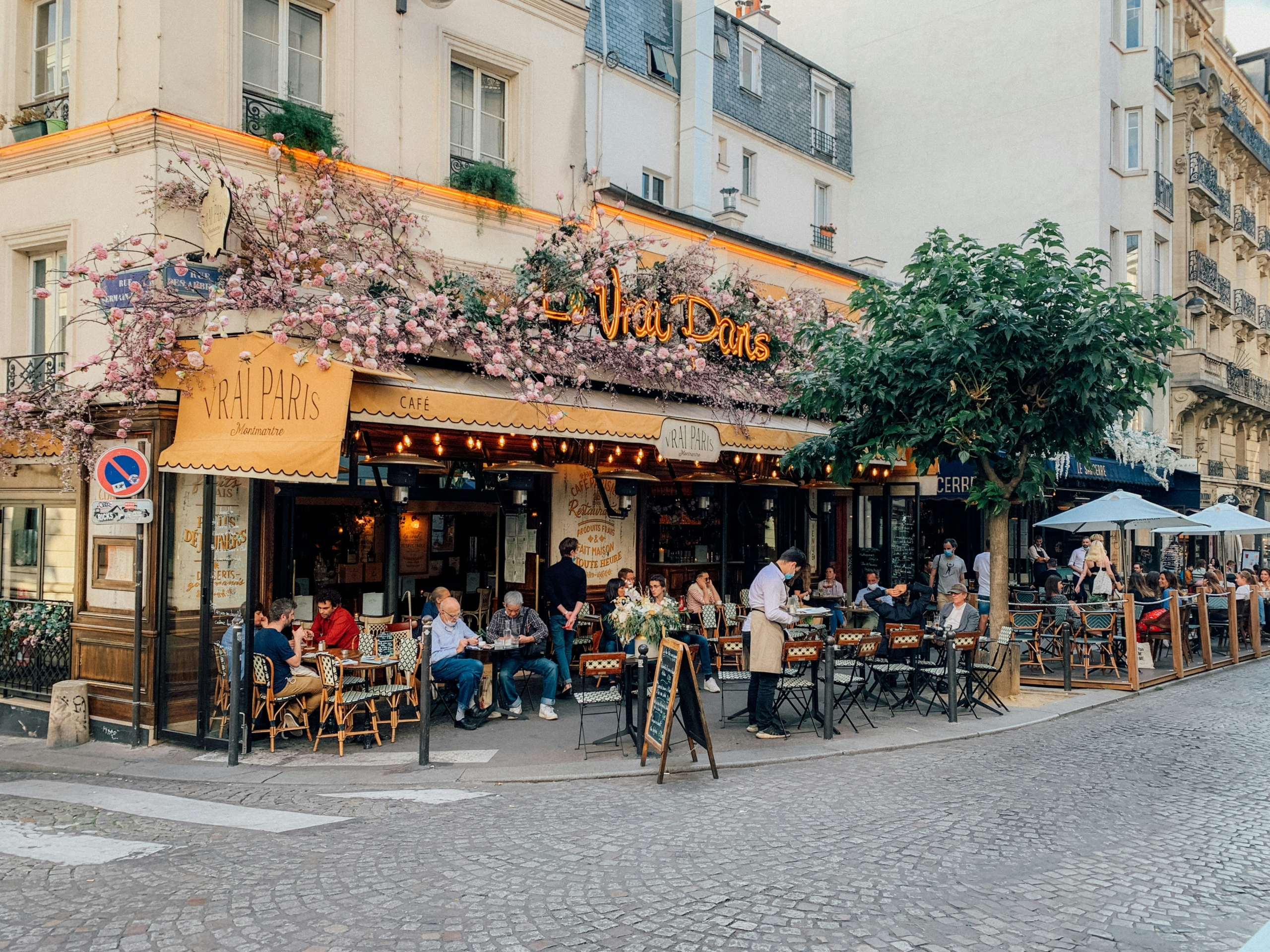
Le Vrai Paris, a popular brasserie in Montmartre, Paris.
Restaurant & Dining Etiquette
Paris’s food culture is complex – and rewarding, for those who take the time to understand it. Dining etiquette in France is quite different from the U.S. Food is an art, meals are intricate, and the proper manners are vital. Below is some general information to help you make the most of dining out in Paris.
- Meals are much later in France than in the U.S. – lunch is often taken between 1:00 p.m. and 3:00 p.m., and dinner service at restaurants often doesn’t begin until 7:00 p.m. or 8:00 p.m.
- Meals in France are lengthy, lasting anywhere from 2–3 hours. If you are in a hurry, let your waiter know right away (and apologize profusely while doing so).
- Familiarize yourself with French restaurant types. Every Parisian restaurant falls into one of several categories – café, brasserie, bistrot, restaurant gastronomique, service rapide, and bar à vin, to name a few. The label of the restaurant is determined by what the restaurant serves, how and when it serves it, and the type of dining etiquette expected by visitors. We recommend brushing up on some of the basics; you can find a list of restaurant category definitions here, and an introductory guide here.
- Be on time for restaurant reservations or risk losing your table.
- Seat yourself. Perhaps the most confusing practice for American tourists is seating etiquette at French restaurants. Unless you have a reservation or there is a sign indicating otherwise, you can usually seat yourself upon arrival at a casual restaurant – there’s no need to wait for a host to show you to a table. If you are unsure, you can always ask a passing waiter, “On peut s’asseoir?” (“Can we sit down?”). In particular, outdoor seating is almost always first-come, first-serve. Just watch out for “set” tables with napkins and glasses amid otherwise clear tables – this usually indicates that the table is reserved.
- Avoid complicating your order by asking for substitutions, adjustments, etc. If you have allergies or dietary restrictions, it is best to call ahead. The French are proud of their food and consider it rude when customers ask for changes to menu items.
- Avoid talking in loud or exaggerated tones. For the French, meals are an intimate experience and you will usually find that noise levels at restaurants are much lower than in the U.S.
- The French consider it rude for waitstaff to interrupt customers while they are dining. If you need to get the attention of a waiter, simply catch their eye and wave or raise your hand (add a “pardon, madame/monsieur” if necessary) and they will make their way over to you.
- French waiters will not bring you the bill unless you ask for it. To ask for your bill at a restaurant, get a waiter’s attention and ask “L'addition, s'il vous plaît” (“The bill, please”). If you are in a hurry, holding your card up while doing so will likely encourage the waiter to bring the payment machine along with the bill. Do note that at some casual/informal restaurants, paying at the front counter is required – if you are unsure, watch other customers to see what they do, or simply ask your waiter.
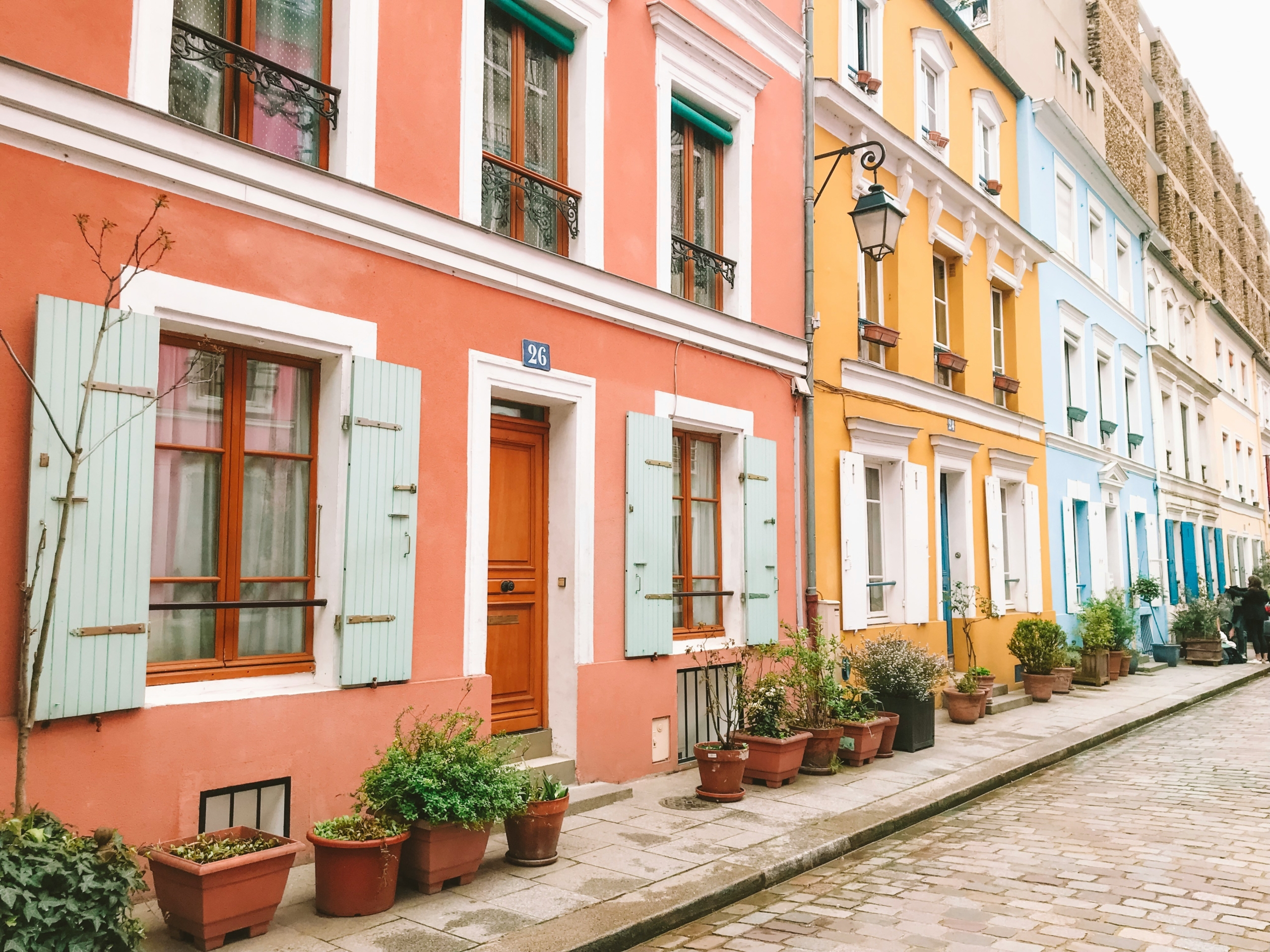
Colorful Rue Crémieux in the 12th arrondissement in Paris.
10 Areas to Visit
- Montemartre – One of the most famous of Paris’s districts, Montemartre is home to the highest point in Paris: Calvaire cemetery, located next to Saint-Pierre de Montmartre church. The village-like, bistro-lined cobblestone streets surround the area’s crown jewel: the Sacré-Cœur, the white basilica visible from nearly every part of Paris.
- Avenue des Champs-Élysées – It almost doesn’t need an introduction. The street counts as one of Paris’s top attractions, lined with luxury shopping venues, classic Parisian white-bricked buildings, cafés, and cultural hotspots such as theaters, art galleries, and historic monuments, including the Arc de Triomphe.
- Le Marais – One of the most historic districts in Paris and the former Jewish quarter, Le Marais showcases cobblestone streets, 17th–18th century buildings, museums such as the Pompidou Centre (housing the largest collection of modern and contemporary art in France) and the Picasso Museum, elegant Place des Vosges, art galleries, and fashion boutiques.
- Île de la Cité – This natural island within the River Seine is best known as the location of the Notre Dame Cathedral. Two of the Seine’s most famous bridges – Pont Neuf and Pont de l’Archevêché – are also located here.
- Le Quartier Latin (The Latin Quarter) – Situated on the left bank of the Seine, this is one of the oldest districts in Paris. You can visit multiple monuments, churches, gardens, and museums while strolling through: Saint-Michel fountain, Musée de Cluny, the Sorbonne, the Pantheon, Grande Mosquée de Paris, Jardin des Plantes and Grandes Serres, Muséum National d’Histoire Naturelle, and much more.
- 1st Arrondissement – Home to the city’s most popular tourist attractions: the Louvre, Jardin des Tuileries, Musee de L’Orangerie, Palais Royal, the French National Library, and more. It’s also the site of many of Paris’s famous patisseries and cafés, including Ladurée and Angelina.
- Saint-Germain-des-Prés – Located right in the center of Paris, this district contains many of Paris’s iconic spots: Musée and Jardin du Luxembourg, L’Odéon – Théâtre de l’Europe, Ponts des Arts across from the Institut de France, and the abbey of Eglise Saint-Germain-des-Prés.
- Canal Saint-Martin – Known for its footbridges, chestnut-tree-lined streets, and retro bistros, the idyllic scenery has provided prime filming spots for films and TV series such as Emily in Paris, Mission: Impossible Fallout, and Amélie.
- La Défense – For a look at modern Paris, visit the city’s business district to the west. Full of the typical traits of a “downtown” area, La Défense boasts skyscrapers, contemporary gardens and walkways, and up-and-coming restaurants and bars that offer a unique look at the “newer” parts of Paris.
- Belleville – The center of diverse immigrant communities, Belleville hosts one of Paris’s several “Chinatowns.” A walk through this district will show you some of Paris’s more “hipster” areas: quiet villages, quaint eateries, unique boutiques, and lovely views. Alternatively, some other areas of this vast neighborhood crossing some four arrondissements feel more cosmopolitan, with bustling streets and various displays of the diverse cultures of the people who live here.
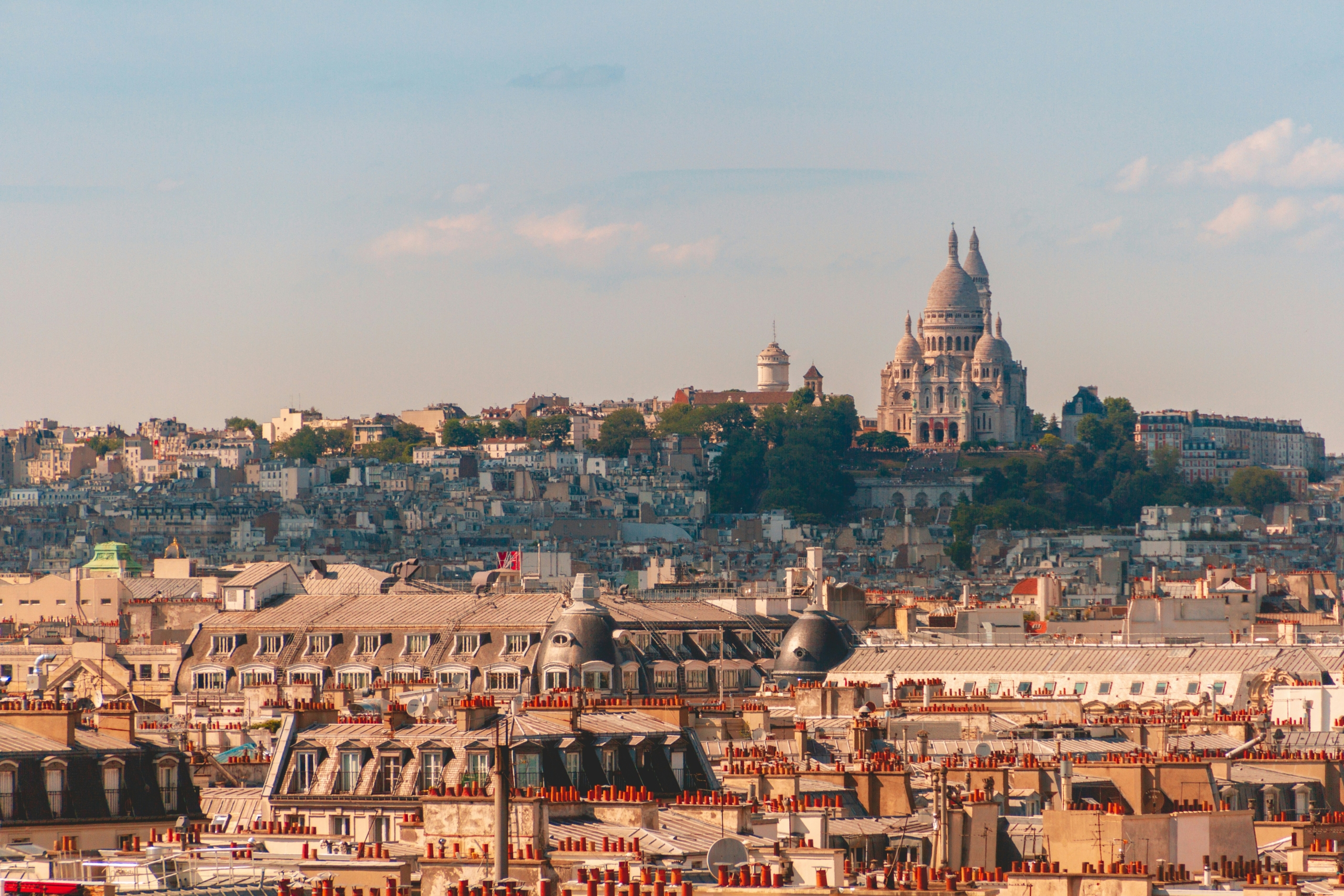
The Basilica of Sacré-Cœur is visible from all over Paris.
10 Famous Attractions
Below, you can find a list of some of the top attractions in Paris along with the arrondissement they are located in.
- Eiffel Tower (7th Arr.) – Of course, seeing the Eiffel Tower is une nécessité when visiting Paris. Make sure to catch the landmark “sparkling” at nighttime!
- Musée de Louvre (1stArr.) – The most-visited museum in the world, the Louvre is best known for its ancient Egyptian, Greek, Roman, and Renaissance art and antiquities – including, of course, Da Vinci’s Mona Lisa and the Winged Victory of Samothrace.
- Musée d’Orsay (7th Arr.) – This former train station is filled with Impressionist and Post-Impressionist art, displaying pieces from such notable artists as Monet, Renoir, Cézanne, and Van Gogh.
- Les Catacombes (14th Arr.) – A network of 185 miles of tunnels runs under Paris, containing the remains of some six million people. The unique arrangement of the skulls and bones of the dead makes this site a must-see.
- Notre Dame Cathedral (4th Arr.) – Set to reopen to the public on December 8, 2024, after a devastating fire in 2019, the cathedral stands as a symbol of Paris and features some of the best examples of French Gothic architecture in the world.
- Arc de Triomphe (8th Arr.) – The massive archway, commissioned by Napoleon I in 1806, honors those who fought for France in the French Revolutionary and Napoleonic wars and remains a symbol of patriotism in France.
- Jardin du Luxembourg (6th Arr.) – Encompassing 60 acres of towering trees, manicured lawns, tranquil pools, and colorful flowers, this garden ranks as the most popular in Paris.
- Musée Rodin (7th Arr.) – Its setting within an 18th-century rococo mansion makes this museum especially romantic. Here, you can view French sculptor Auguste Rodin’s most spectacular work and visit the famed sculpture garden.
- Basilica of Sacré-Cœur (18th Arr.) – You can spot the dome of the white basilica from nearly anywhere in Paris, perched atop a hill in the Montmartre district. From Sacré-Cœur itself, you can not only enjoy the ornate building, but also get fantastic views of the city.
- Palais Garnier (9th Arr) – Even if you’re not here to see a performance, the building itself is worth a visit. Within the opulent theater, frescoes, sculptures, and ornate architecture abound.
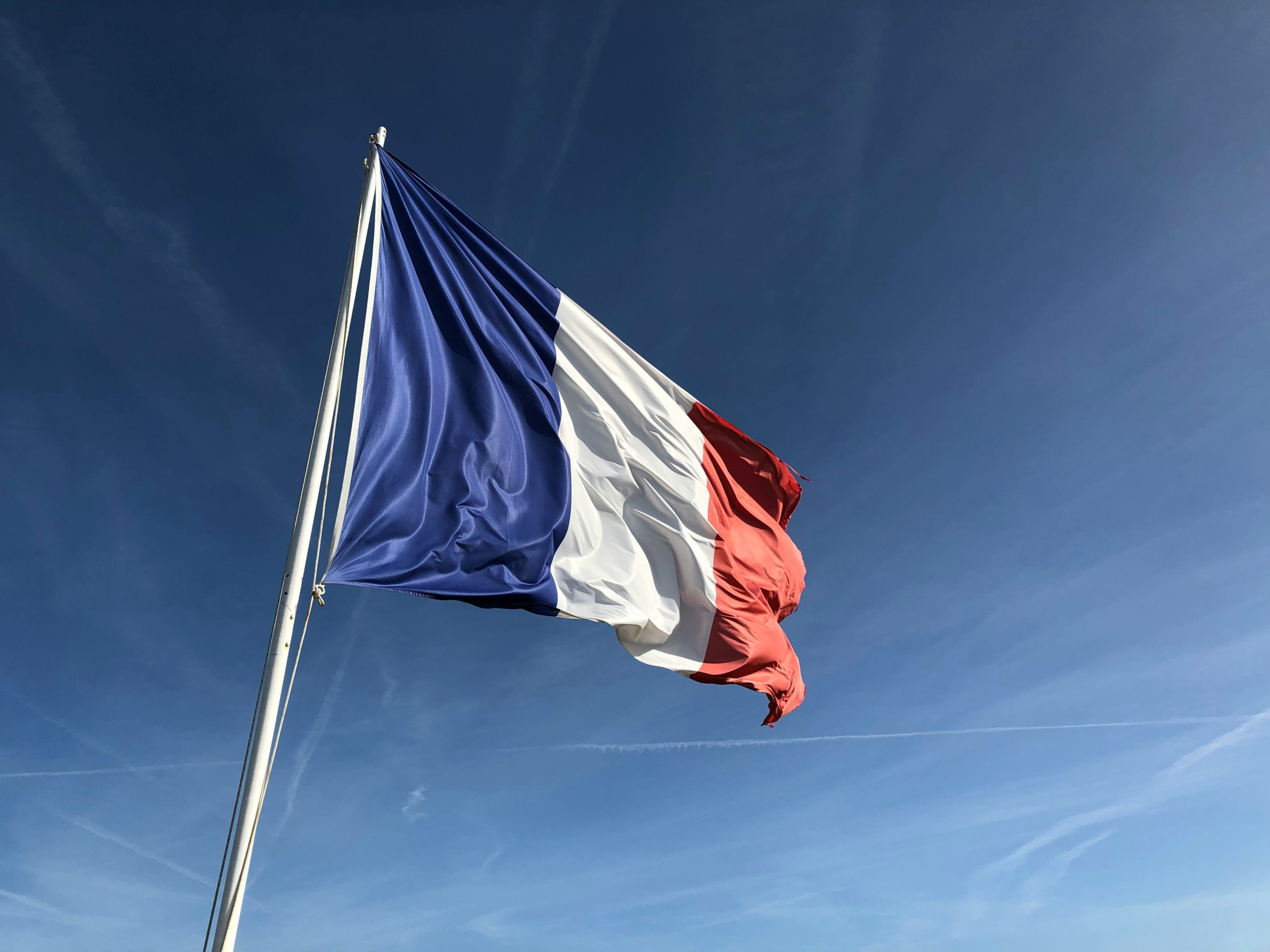
The Tricolour, France’s official flag.
Useful Tips & Information
- Plan your itinerary in advance. There’s so much to see in Paris that it’s almost impossible to visit everything in one trip – so, make a specific plan for what you want to do each day. But be sure to leave time for people-watching, café-sitting, and wandering, as well!
- Learn some basic French and be prepared to use it. The French prefer speaking their own language and appreciate foreigners who attempt to communicate with them in French. Don’t assume that every French person is fluent in English – some may even consider it rude to be approached in English first. It would be wise to download a translation app such as Google Translate to use in a pinch. You can find a list of some basic French words and phrases here.
- Familiarize yourself with French social norms. Stereotypes say that the French are rude, but this is far from the case. They simply value quiet existence and give strangers space to go about their days uninterrupted; loud conversation, laughter, and big smiles are not the standard in public. Though this may seem cold and standoffish to Americans, who are used to small talk and open expression of emotions, this is simply the French’s way of respecting others. To them, being as unobtrusive as possible shows kindness.
- Know your manners. The French follow strict social rules when interacting with strangers. When entering any establishment, you should always make eye contact with an employee and say “bonjour” (and when leaving, say “merci, bonne journée/nuit,” meaning “thank you, good day/night”). All other interactions with local people should also start with eye contact and a friendly “bonjour.” Remember to ask, “Vous parlez anglais?” (“Do you speak English?”) before attempting to speak English to a French person. Make ample use of “pardon” and “excusez-moi” when getting people’s attention and when moving through crowded areas. Say “merci” (“thank you”) to waiters, service workers, and anyone else who lends a helping hand.
- Make restaurant reservations and buy attraction tickets far in advance. Paris is the most visited city in the world, so you can imagine how busy some attractions can get.
- Dress up. Paris is the capital of fashion, and Parisians are known for their casual-yet-put-together street fashion. You may wish to pack some dressier – but comfortable – outfits for when you’re out and about. Not only will this help you blend in, but it keeps you safe; brightly colored and/or overly casual clothing can mark you as a tourist and make you an easy target for pickpockets.
- Be cautious when crossing the road. Parisian roads are extremely busy with cars, buses, bikes, scooters, and motorcycles, and drivers are known to be rather aggressive. Above all else, for your own safety, do not jaywalk, do not walk across rotaries, diligently follow all pedestrian signage, and look in all directions before stepping onto the street.
- Consider buying a Paris Museum Pass. This is the cheapest option if you plan to hop between the more popular museums in Paris.
- Tipping at restaurants is not customary. However, if you are very pleased with your service and/or your meal, a small tip (5–10% of the bill) is always appreciated.
Useful Apps
Google Translate – Instantly translate text, speech, and even images in over 100 languages, including French.
Google Lens –This image recognition tool can translate text in real time; just point your smartphone camera at signs, menus, or any other text to see the English translation.
Citymapper Paris – Similar to Google maps, but customized for Paris travelers.
RATP App – The official Metro app for Paris and a go-to source for everything related to Paris’s public transportation system.
Duolingo – A free language learning app. There’s even an option to customize your lessons to teach you useful words and phrases for travel.
Urbs Travel App – Offers personalized information, recommendations, audio descriptions, routes, guides, and more for Paris attractions, restaurants, and historical sites. Great for finding off-the-beaten-path experiences.
The Fork – A local favorite for finding restaurants and making dining reservations online.
Useful Websites
parisjetaime.com/eng
www.visitparisregion.com/en
www.introducingparis.com
www.parisunlocked.com
